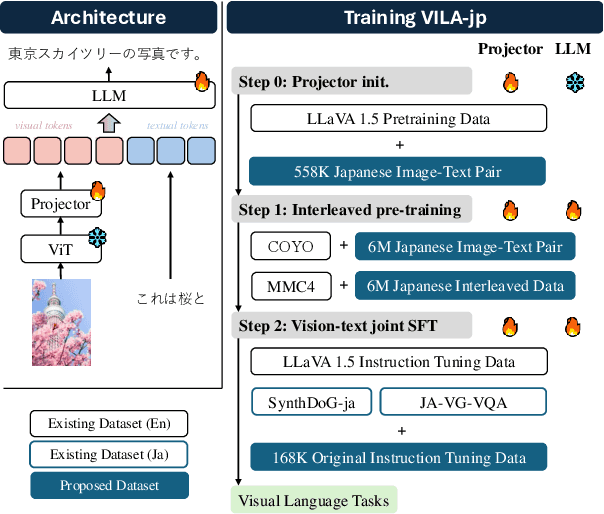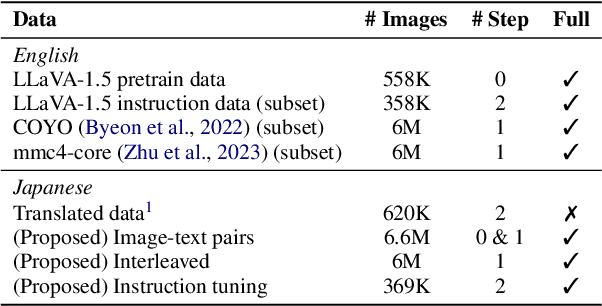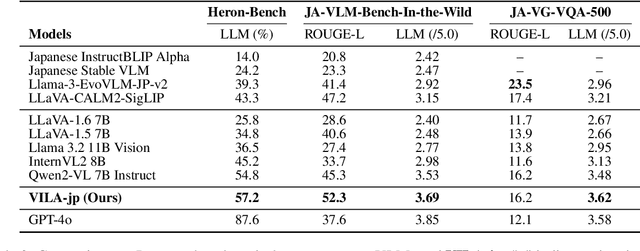Naoaki Okazaki
Bit-level BPE: Below the byte boundary
Jun 09, 2025Abstract:Byte-level fallbacks for subword tokenization have become a common practice in large language models. In particular, it has been demonstrated to be incredibly effective as a pragmatic solution for preventing OOV, especially in the context of larger models. However, breaking a character down to individual bytes significantly increases the sequence length for long-tail tokens in languages such as Chinese, Japanese, and Korean (CJK) and other character-diverse contexts such as emoji. The increased sequence length results in longer computation during both training and inference. In this work, we propose a simple compression technique that reduces the sequence length losslessly.
Rewriting Pre-Training Data Boosts LLM Performance in Math and Code
May 05, 2025Abstract:The performance of large language models (LLMs) in program synthesis and mathematical reasoning is fundamentally limited by the quality of their pre-training corpora. We introduce two openly licensed datasets, released under the Llama 3.3 Community License, that significantly enhance LLM performance by systematically rewriting public data. SwallowCode (approximately 16.1 billion tokens) refines Python snippets from The-Stack-v2 through a novel four-stage pipeline: syntax validation, pylint-based style filtering, and a two-stage LLM rewriting process that enforces style conformity and transforms snippets into self-contained, algorithmically efficient examples. Unlike prior methods that rely on exclusionary filtering or limited transformations, our transform-and-retain approach upgrades low-quality code, maximizing data utility. SwallowMath (approximately 2.3 billion tokens) enhances Finemath-4+ by removing boilerplate, restoring context, and reformatting solutions into concise, step-by-step explanations. Within a fixed 50 billion token training budget, continual pre-training of Llama-3.1-8B with SwallowCode boosts pass@1 by +17.0 on HumanEval and +17.7 on HumanEval+ compared to Stack-Edu, surpassing the baseline model's code generation capabilities. Similarly, substituting SwallowMath yields +12.4 accuracy on GSM8K and +7.6 on MATH. Ablation studies confirm that each pipeline stage contributes incrementally, with rewriting delivering the largest gains. All datasets, prompts, and checkpoints are publicly available, enabling reproducible research and advancing LLM pre-training for specialized domains.
Building Instruction-Tuning Datasets from Human-Written Instructions with Open-Weight Large Language Models
Mar 31, 2025Abstract:Instruction tuning is crucial for enabling Large Language Models (LLMs) to solve real-world tasks. Prior work has shown the effectiveness of instruction-tuning data synthesized solely from LLMs, raising a fundamental question: Do we still need human-originated signals for instruction tuning? This work answers the question affirmatively: we build state-of-the-art instruction-tuning datasets sourced from human-written instructions, by simply pairing them with LLM-generated responses. LLMs fine-tuned on our datasets consistently outperform those fine-tuned on existing ones. Our data construction approach can be easily adapted to other languages; we build datasets for Japanese and confirm that LLMs tuned with our data reach state-of-the-art performance. Analyses suggest that instruction-tuning in a new language allows LLMs to follow instructions, while the tuned models exhibit a notable lack of culture-specific knowledge in that language. The datasets and fine-tuned models will be publicly available. Our datasets, synthesized with open-weight LLMs, are openly distributed under permissive licenses, allowing for diverse use cases.
Intent-Aware Self-Correction for Mitigating Social Biases in Large Language Models
Mar 08, 2025Abstract:Self-Correction based on feedback improves the output quality of Large Language Models (LLMs). Moreover, as Self-Correction functions like the slow and conscious System-2 thinking from cognitive psychology's perspective, it can potentially reduce LLMs' social biases. LLMs are sensitive to contextual ambiguities and inconsistencies; therefore, explicitly communicating their intentions during interactions when applying Self-Correction for debiasing is crucial. In this study, we demonstrate that clarifying intentions is essential for effectively reducing biases in LLMs through Self-Correction. We divide the components needed for Self-Correction into three parts: instruction, response, and feedback, and clarify intentions at each component. We incorporate an explicit debiasing prompt to convey the intention of bias mitigation from the instruction for response generation. In the response, we use Chain-of-Thought (CoT) to clarify the reasoning process. In the feedback, we define evaluation aspects necessary for debiasing and propose clear feedback through multi-aspect critiques and scoring. Through experiments, we demonstrate that self-correcting CoT responses obtained from a debiasing prompt based on multi-aspect feedback can reduce biased responses more robustly and consistently than the baselines. We also find the variation in debiasing efficacy when using models with different bias levels or separating models for response and feedback generation.
LCTG Bench: LLM Controlled Text Generation Benchmark
Jan 27, 2025



Abstract:The rise of large language models (LLMs) has led to more diverse and higher-quality machine-generated text. However, their high expressive power makes it difficult to control outputs based on specific business instructions. In response, benchmarks focusing on the controllability of LLMs have been developed, but several issues remain: (1) They primarily cover major languages like English and Chinese, neglecting low-resource languages like Japanese; (2) Current benchmarks employ task-specific evaluation metrics, lacking a unified framework for selecting models based on controllability across different use cases. To address these challenges, this research introduces LCTG Bench, the first Japanese benchmark for evaluating the controllability of LLMs. LCTG Bench provides a unified framework for assessing control performance, enabling users to select the most suitable model for their use cases based on controllability. By evaluating nine diverse Japanese-specific and multilingual LLMs like GPT-4, we highlight the current state and challenges of controllability in Japanese LLMs and reveal the significant gap between multilingual models and Japanese-specific models.
HarmonicEval: Multi-modal, Multi-task, Multi-criteria Automatic Evaluation Using a Vision Language Model
Dec 19, 2024



Abstract:Vision-language models (VLMs) have shown impressive abilities in text and image understanding. However, existing metrics for evaluating the text generated by VLMs focus exclusively on overall quality, leading to two limitations: 1) it is challenging to identify which aspects of the text need improvement from the overall score; 2) metrics may overlook specific evaluation criteria when predicting an overall score. To address these limitations, we propose HarmonicEval, a reference-free evaluation metric that aggregates criterion-wise scores to produce the overall score in a bottom-up manner. Furthermore, we construct the Multi-task Multi-criteria Human Evaluation (MMHE) dataset, which comprises 18,000 expert human judgments across four vision-language tasks. Our experiments demonstrate that HarmonicEval achieves higher correlations with human judgments than conventional metrics while providing numerical scores for each criterion.
Why We Build Local Large Language Models: An Observational Analysis from 35 Japanese and Multilingual LLMs
Dec 19, 2024



Abstract:Why do we build local large language models (LLMs)? What should a local LLM learn from the target language? Which abilities can be transferred from other languages? Do language-specific scaling laws exist? To explore these research questions, we evaluated 35 Japanese, English, and multilingual LLMs on 19 evaluation benchmarks for Japanese and English, taking Japanese as a local language. Adopting an observational approach, we analyzed correlations of benchmark scores, and conducted principal component analysis (PCA) on the scores to derive \textit{ability factors} of local LLMs. We found that training on English text can improve the scores of academic subjects in Japanese (JMMLU). In addition, it is unnecessary to specifically train on Japanese text to enhance abilities for solving Japanese code generation, arithmetic reasoning, commonsense, and reading comprehension tasks. In contrast, training on Japanese text could improve question-answering tasks about Japanese knowledge and English-Japanese translation, which indicates that abilities for solving these two tasks can be regarded as \textit{Japanese abilities} for LLMs. Furthermore, we confirmed that the Japanese abilities scale with the computational budget for Japanese text.
Constructing Multimodal Datasets from Scratch for Rapid Development of a Japanese Visual Language Model
Oct 30, 2024



Abstract:To develop high-performing Visual Language Models (VLMs), it is essential to prepare multimodal resources, such as image-text pairs, interleaved data, and instruction data. While multimodal resources for English are abundant, there is a significant lack of corresponding resources for non-English languages, such as Japanese. To address this problem, we take Japanese as a non-English language and propose a method for rapidly creating Japanese multimodal datasets from scratch. We collect Japanese image-text pairs and interleaved data from web archives and generate Japanese instruction data directly from images using an existing VLM. Our experimental results show that a VLM trained on these native datasets outperforms those relying on machine-translated content.
Tokenization as Finite-State Transduction
Oct 21, 2024



Abstract:Tokenization is the first step in modern neural language model pipelines where an input text is converted to a sequence of subword tokens. We introduce from first principles a finite-state transduction framework which can efficiently encode all possible tokenizations of a regular language. We then constructively show that Byte-Pair Encoding (BPE) and MaxMatch (WordPiece), two popular tokenization schemes, fit within this framework. For BPE, this is particularly surprising given its resemblance to context-free grammar and the fact that it does not tokenize strings from left to right. An application of this is to guided generation, where the outputs of a language model are constrained to match some pattern. Here, patterns are encoded at the character level, which creates a mismatch between the constraints and the model's subword vocabulary. While past work has focused only on constraining outputs without regard to the underlying tokenization algorithm, our framework allows for simultaneously constraining the model outputs to match a specified pattern while also adhering to the underlying tokenizer's canonical tokenization.
Distributional Properties of Subword Regularization
Aug 21, 2024



Abstract:Subword regularization, used widely in NLP, improves model performance by reducing the dependency on exact tokenizations, augmenting the training corpus, and exposing the model to more unique contexts during training. BPE and MaxMatch, two popular subword tokenization schemes, have stochastic dropout regularization variants. However, there has not been an analysis of the distributions formed by them. We show that these stochastic variants are heavily biased towards a small set of tokenizations per word. If the benefits of subword regularization are as mentioned, we hypothesize that biasedness artificially limits the effectiveness of these schemes. Thus, we propose an algorithm to uniformly sample tokenizations that we use as a drop-in replacement for the stochastic aspects of existing tokenizers, and find that it improves machine translation quality.
 Add to Chrome
Add to Chrome Add to Firefox
Add to Firefox Add to Edge
Add to Edge